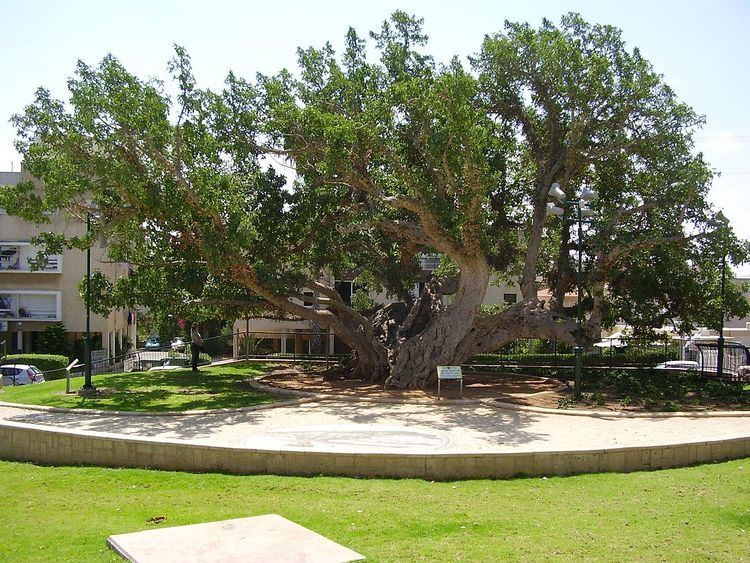Arabic أم خالد Palestine grid 137/192 | Area 2,894 dunams Date of depopulation 20 March 1948 | |
 | ||
Also spelled Mukhalid, Castellare Rogerii Longobardi Cause(s) of depopulation Fear of being caught up in the fighting Weather 13°C, Wind SE at 11 km/h, 91% Humidity | ||
Tracing all that remains of umm khalid
Umm Khalid (Arabic: أم خالد), also called Mukhalid, was a Palestinian village in the Tulkarm Subdistrict, 15 kilometers (9.3 mi) west of Tulkarm. It was an ancient site in the central coastline of what is now the city of Netanya, Israel.
Contents
Tracing all that remains of umm khalid
History
Flint tools found around the area suggest that the site might have been inhabited since prehistoric times. Remnants of buildings, installations and burial caves dating from the first century BCE have been found. The village site contained the Lombard Castle of Roger, built by the Crusaders. The building was mentioned in 1135, mostly destroyed c. 1948, and partly excavated in 1985/86. It appears to have been continuously in use from the Crusader period until 1948. Archaeological findings around the village included the remains of towers, fortresses, wells, reservoirs, cisterns, and pottery.
Ottoman era
The village was named Omm Kaled on a 1799 map of the area, and the village was razed by the troops of Napoleon during their return to Egypt after their failed siege of Acre in 1799.
The British traveller James Silk Buckingham, who passed through the village ("El Mukalid") in 1816, described it as still "rather poor", while noting that the village resembled an Egyptian one in form and constructions of its huts.
In the 19th century, Umm Khalid was a rest area between al-Tantura and Ras al-Ayn, where Ottoman officials stopped and received dignitaries. When Mary Rogers, the sister of the British vice-consul in Haifa, visited the Umm Khalid in 1856 she described it as a flourishing village, and noted the extensive melon gardens to the west of the village.
In 1873, the village was described as "A small mud village, with ruins, and a sacred place to the south. On the east is a good masonry well, with troughs and a wheel for raising the water. ... There are also cisterns, and a pond with mud banks. There are cornfields to the east, but the soil is very sandy. The place is famous for its water melons, which are shipped at the little harbour called Minet Abu Zabura." Among the ruins were seen a vaulted building with remnants of a second story, a well built well, and six circular rock-cut granaries.
British Mandate era
In the 1922 census of Palestine there were 307 villagers, all Muslim, increasing in the 1931 census to 586; 580 Muslims and 6 Christians, in a total of 131 houses.
At the village center was a mosque, an elementary school for boys, and four shops for groceries and fabrics. In 1944/45, a total of 47 dunums was used for citrus and bananas, while 1,830 dunums were planted with cereals. At the same time, it was registered that 2,894 dunums of land was Arab owned, 882 Jewish owned, while 89 dunam was public property.
1948 and after
According to an Israeli military report, Umm Khalid was evacuated 20 March 1948. The village was located in an area which was regarded by the Zionist leadership as the core of the planned Jewish state, and in their view it was therefore desirable that the Arab residents were made to leave before 15 May.
The American historian Rosemarie Esber interviewed refugees from Umm Khalid. According to Ahamed 'Uthman, Zionist surrounded and blockaded the village in 1947, and continued into 1948:
"[The Jews] did not allow any to enter or leave the village. They did not allow us to sell or buy anything from outside the village.....After a month of the Jewish blockade, some families left. [..] We had been awaiting the end of the blockade, but it would not end unless the people left...They were shooting, but not heavily. They shot from outside the village to make the villagers afraid. No one returned to Umm Khalid. We were not allowed to return....Jews killed many people in Mlabis and in many other places....What did they do in Dayr Yassin?...I thank God we left before they entered the village."
Much of the village land has been engulfed by the suburbs of the city of Netanya, founded in 1929 one kilometer to the west. The settlement of Gan Chefer, founded in 1940, and Nira, founded in 1941, were merged in 1953 to form a single, large settlement named Shaar Chefer; this settlement covers part of the village land.
According to the Palestinian historian Walid Khalidi, the structures on the village land were in 1992: "The village site has become part of the city of Netanya. Some houses remain and are used either as residences or for commercial purposes such as warehouses for Israeli companies. The land in the vicinity are planted in citrus trees.
In 1997, bulldozers leveling ground for a school building in Netanya uncovered remains of the cemetery of Umm Khalid. The Aqsa Association for the Preservation of Consecrated Islamic Property petitioned the High Court of Justice. As a result, the city of Netanya agreed to halt work in the area which had not been damaged, and to put up a sign: "Here is the Muslim cemetery of the village Umm Khalid." The Muslims refused to accept that the area should be turned into a park, stating that "No foot shall tread on the graves."
